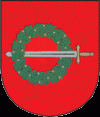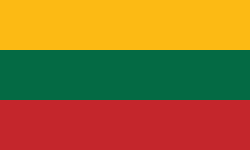Gargždai
 |
Gargždai is the Lithuanian name of the city. Versions of the name in other languages include Polish: Gorżdy, Russian: Горжды Gorzhdy, Belarusian: Го́ржды Horzhdy, Yiddish: גורזד Gorzhd, German: Garsden.
The number of Jewish residents of Gargzdai killed by the Nazi Einsatzkommando death squad during the Holocaust is at least 500 including 200 men killed on June 24, 1941, and 300 women with children killed on September 14 and 16, 1941. The killings were perpetrated by Einsatzgruppe A under the command of SS Brigadeführer Walter Stahlecker, and documented in the Jäger report.
Map - Gargždai
Map
Country - Lithuanian_Soviet_Socialist_Republic_(1918–1919)
 |
 |
| Flag of Lithuania | |
Germany had lost World War I and signed the Compiègne Armistice on 11 November 1918. Its military forces then started retreating from the former Ober Ost territories. Two days later, the government of the Soviet Russia renounced the Treaty of Brest-Litovsk, which had assured Lithuania's independence. Soviet forces then launched a westward offensive against Estonia, Latvia, Lithuania, Poland and Ukraine in an effort to spread the global proletarian revolution and replace national independence movements with Soviet republics. Their forces followed retreating German troops and reached Lithuania by the end of December 1918.
Currency / Language
| ISO | Currency | Symbol | Significant figures |
|---|---|---|---|
| EUR | Euro | € | 2 |
| ISO | Language |
|---|---|
| LT | Lithuanian language |
| PL | Polish language |
| RU | Russian language |















